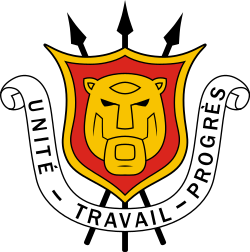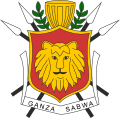| Coat of arms of Burundi | |
|---|---|
 | |
| Armiger | Republic of Burundi |
| Adopted | 1966 |
| Motto | Unité, Travail, Progrès (French: "Unity, Work, Progress") |
The coat of arms of Burundi, adopted in 1966, consists of a shield surrounded by three spears. On the shield is the motto of the nation, as well as the head of a lion. Behind the shield there are three crossed traditional African spears. Under the shield the national motto of Burundi appears on a scroll: Unité, Travail, Progrès (French: "Unity, Work, Progress").
Official description
The constitution of Burundi describes the coat of arms as follows:
The motto of Burundi is "Unité, Travail, Progrès". The emblem of the Republic is a shield charged with a head of a lion, together with three spears, the whole surrounded by the national motto.
History
The previous coat of arms of the Kingdom of Burundi, used from 1962 until 1966, looked very similar, except that the royal karyenda drum was surmounted on the top as a symbol of the mwami (king), surrounded by two laurels. The number of spears was four. The national motto was Ganza Sabwa, which is in Kirundi and roughly means "(the mwami) rules and reigns".
Gallery
-
 Coat of arms of The German East Africa Company
Coat of arms of The German East Africa Company
-
 Proposed Coat of arms of The German East Africa (1914)
Proposed Coat of arms of The German East Africa (1914)
-
 Coat of arms of Ruanda-Urundi (1916-1962)
Coat of arms of Ruanda-Urundi (1916-1962)
-
 Coat of arms of the Kingdom of Burundi (1962–1966)
Coat of arms of the Kingdom of Burundi (1962–1966)
References
- Guide to the Flags of the World by Mauro Talocci, revised and updated by Whitney Smith (ISBN 0-688-01141-1), p. 153.
- "IBWIRIZWA SHINGIRO RYA REPUBURIKA Y'UBURUNDI" [Constitution of the Republic of Burundi] (PDF) (in French and Kirundi). Assemblée Nationale du Burundi. Archived from the original (PDF) on 2021-03-10. Retrieved 2021-03-10.
{{cite web}}: CS1 maint: unrecognized language (link) - Unlocking Horns: Forgiveness and Reconciliation in Burundi, p. 16, at Google Books
| Armorial of Africa | |
|---|---|
| Sovereign states |
|
| States with limited recognition | |
| Dependencies and other territories |
|
This Burundi-related article is a stub. You can help Misplaced Pages by expanding it. |
This heraldry-related article is a stub. You can help Misplaced Pages by expanding it. |